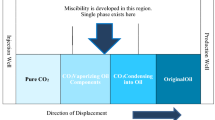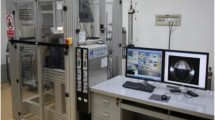Abstract
The sufficient energy to transfer the crude oil to the surficial wellbore facilities would be reduced dramatically which was done by CO2, especially for heavy and super-heavy oil reservoirs. The objective of this comprehensive study is to measure the considerable influence of CO2 solubility on the recovery factor, density, viscosity at different pressures and temperatures. According to the results of this study, recovery factor at the pressure of 0.2 MPa and 0.5 MPa experienced the lowest recovery factor among other pressures. They were about 38.37% and 43.81% after the injection of about 15 pore volumes of CO2. For the pressures of 1 MPa, 2 MPa, 3 MPa, and 4 MPa, at the first stages of CO2 injection (up to 3 pore volumes of CO2 injection), the recovery factor experienced the same value. Since then, by the increase in pressure from 1 to 4 MPa, the recovery factor was increased slightly. Moreover, recovery factor at the temperature of 333 K was measured about 34.5%. The measured recovery factor for other temperatures was 40.17%, 47.68%, 51.97%, 58.42%, and 63.54% at the temperature of 363 K, 393 K, 423 K, 453 K, and 483 K, respectively. On the other hand, the density of heavy oil which was saturated with CO2 was decreased with the increase in pressure and temperature and the higher temperatures caused the lower effect on the viscosity and density of heavy oil. Consequently, the dissolution of CO2 had decreased the heavy oil viscosity in the higher temperatures and pressures, and due to the increase in pressure and temperature, the heavy oil recovery factor was increased. Furthermore, the recovery factor for the 70 mL min−1 of CO2 injection was lower than the 700 mL min−1 of CO2 injection.











Similar content being viewed by others

References
Al-Bayati D, Saeedi A, Myers M, et al. Insight investigation of miscible SCCO2 water alternating gas (WAG) injection performance in heterogeneous sandstone reservoirs. J CO2 Util. 2018;28:255–63.
Ampomah W, Balch R, Cather M, et al. Optimum design of CO2 storage and oil recovery under geological uncertainty. Appl Energy. 2017;195:80–92.
Bayat Ali E, Junin R, Hejri S, et al. Application of CO2-based vapor extraction process for high pressure and temperature heavy oil reservoirs. J Pet Sci Eng. 2015;135:280–90.
Bayestehparvin B, Abedi J, Ali S. Non-equilibrium reservoir simulation of solvent-steam processes, based on mass and heat transfer inside a pore. In: SPE reservoir simulation conference. Society of Petroleum Engineers; 2017.
Bera A, Mandal A. Microemulsions: a novel approach to enhanced oil recovery: a review. J Pet Explor Prod Technol. 2015;5:255–68.
Chen S, Li H, Yang D. Optimization of production performance in a CO2 flooding reservoir under uncertainty. J Can Pet Technol. 2010;49:71–8.
Colonna S, Bastianini M, Sisani M, et al. CO2 adsorption and desorption properties of calcined layered double hydroxides. J Therm Anal Calorim. 2018;133:869–79.
Cui M, Wang R, Lv C, et al. Research on microscopic oil displacement mechanism of CO2 EOR in extra-high water cut reservoirs. J Pet Sci Eng. 2017;154:315–21.
Davarpanah A. Feasible analysis of reusing flowback produced water in the operational performances of oil reservoirs. Environ Sci Pollut Res. 2018;25:35387–95.
Davarpanah A. A feasible visual investigation for associative foam > polymer injectivity performances in the oil recovery enhancement. Eur Poly J. 2018;105:405–11.
Davarpanah A. The integrated feasibility analysis of water reuse management in the petroleum exploration performances of unconventional shale reservoirs. Appl Water Sci. 2018;8:75.
Davarpanah A, Akbari E, Doudman-Kushki M, et al. Simultaneous feasible injectivity of foam and hydrolyzed polyacrylamide to optimize the oil recovery enhancement. Energy Explor Exploit. 2019;37:44–59.
Davarpanah A, Mirshekari B. Experimental study and field application of appropriate selective calculation methods in gas lift design. Pet Res. 2018;3:239–47.
Davarpanah A, Mirshekari B. A simulation study to control the oil production rate of oil-rim reservoir under different injectivity scenarios. Energy Rep. 2018;4:664–70.
Davarpanah A, Mirshekari B, Behbahani TJ, Hemmati M. Integrated production logging tools approach for convenient experimental individual layer permeability measurements in a multi-layered fractured reservoir. J Pet Explor Prod Technol. 2018;8(3):743–51.
Davarpanah A, Mirshekari B. Mathematical modeling of injectivity damage with oil droplets in the waste produced water re-injection of the linear flow. Eur Phys J Plus. 2019;134(4):180. https://doi.org/10.1140/epjp/i2019-12546-9.
Davarpanah A, Shirmohammadi R, Mirshekari B. Experimental evaluation of polymer-enhanced foam transportation on the foam stabilization in the porous media. Int J Environ Sci Technol. 2019. https://doi.org/10.1007/s13762-019-02280-z.
Deng J, Song J-J, Zhao J-Y, et al. Gases and thermal behavior during high-temperature oxidation of weathered coal. J Therm Anal Calorim. 2019. https://doi.org/10.1007/s10973-019-08103-0.
Ding M, Yuan F, Wang Y, et al. Oil recovery from a CO2 injection in heterogeneous reservoirs: the influence of permeability heterogeneity, CO2–oil miscibility and injection pattern. J Nat Gas Sci Eng. 2017;44:140–9.
Ebadati A, Akbari E, Davarpanah A. An experimental study of alternative hot water alternating gas injection in a fractured model. Energy Explor Exploit. 2018;37(3):945–59. https://doi.org/10.1177/0144598718815247.
Ebadati A, Davarpanah A, Mirshekari B. Stimulated-based characterization recovery enhancement feedback of oil-rim reservoirs. Energy Sources Part A Recovery Util Environ Eff. 2018;40:2528–41.
Ganjkhanlou Y, Bulánek R, Kikhtyanin O, et al. Study on thermal stabilities and symmetries of chemisorbed species formed on K-zeolites upon CO2 adsorption by TPD and in situ IR spectroscopy. J Therm Anal Calorim. 2018;133:355–64.
Giraldo L, Moreno-Piraján JC. CO2 adsorption on activated carbon prepared from mangosteen peel. J Therm Anal Calorim. 2018;133:337–54.
Gu H, Cheng L, Huang S, et al. Steam injection for heavy oil recovery: modeling of wellbore heat efficiency and analysis of steam injection performance. Energy Convers Manag. 2015;97:166–77.
He L, Ping-ping S, Xin-wei L, Qi-Chao G, Cheng-sheng W, Fangfang L. Study on CO2 EOR and its geological sequestration potential in oil field around Yulin city. J Pet Sci Eng. 2015;134:199–204.
Huang S, Cao M, Cheng L. Experimental study on the mechanism of enhanced oil recovery by multi-thermal fluid in offshore heavy oil. Int J Heat Mass Transf. 2018;122:1074–84.
Jadhawar PS, Sarma HK. Effect of well pattern and injection well type on the CO2-assisted gravity drainage enhanced oil recovery. J Pet Sci Eng. 2012;98–99:83–94.
Kamari A, Sattari M, Mohammadi AH, et al. Reliable method for the determination of surfactant retention in porous media during chemical flooding oil recovery. Fuel. 2015;158:122–8.
Kavousi A, Torabi F, Chan CW, et al. Experimental measurement and parametric study of CO2 solubility and molecular diffusivity in heavy crude oil systems. Fluid Phase Equilib. 2014;371:57–66.
Kristóf J, Inczédy J. Continuous determination of carbon dioxide evolved during thermal decomposition reactions. J Therm Anal. 1993;40:993–8.
Lei H, Yang S, Zu L, et al. Oil recovery performance and CO2 storage potential of CO2 water-alternating-gas injection after continuous CO2 injection in a multilayer formation. Energy Fuels. 2016;30:8922–31.
Liu Y, Han X, Zou J, et al. New progress of the offshore thermal recovery technologies in Bohai Bay, China. In: SPE/IATMI Asia Pacific oil & gas conference and exhibition. Society of Petroleum Engineers. 2017.
Mazarei M, Davarpanah A, Ebadati A, et al. The feasibility analysis of underground gas storage during an integration of improved condensate recovery processes. J Pet Explor Prod Technol. 2019;9:397–408.
Neves Junior A, Dweck J, Filho RDT, et al. Determination of CO2 capture during accelerated carbonation of engineered cementitious composite pastes by thermogravimetry. J Therm Anal Calorim. 2019. https://doi.org/10.1007/s10973-019-08210-y.
Pang Z-x, Z-b Wu, Zhao M. A novel method to calculate consumption of non-condensate gas during steam assistant gravity drainage in heavy oil reservoirs. Energy. 2017;130:76–85.
Pang Z, Lyu X, Zhang F, et al. The macroscopic and microscopic analysis on the performance of steam foams during thermal recovery in heavy oil reservoirs. Fuel. 2018;233:166–76.
Park S, Lee ES, Sulaiman WRW. Adsorption behaviors of surfactants for chemical flooding in enhanced oil recovery. J Ind Eng Chem. 2015;21:1239–45.
Seyyedsar SM, Sohrabi M. Intermittent CO2 and viscosity-reducing gas (VRG) injection for enhanced heavy oil recovery. Fuel Process Technol. 2017;164:1–12.
Singh H, Cai J. Screening improved recovery methods in tight-oil formations by injecting and producing through fractures. Int J Heat Mass Transf. 2018;116:977–93.
Sohrabi M, Jamiolahmady M, Al Quraini A. Heavy oil recovery by liquid CO2/water injection. In: EUROPEC/EAGE conference and exhibition. Society of Petroleum Engineers. 2007.
Stalgorova E, Babadagli T. Modified Random Walk–Particle Tracking method to model early time behavior of EOR and sequestration of CO2 in naturally fractured oil reservoirs. J Pet Sci Eng. 2015;127:65–81.
Sun F, Yao Y, Chen M, et al. Performance analysis of superheated steam injection for heavy oil recovery and modeling of wellbore heat efficiency. Energy. 2017;125:795–804.
Tavakoli HM, Jamialahmadi M, Kord S, et al. Experimental investigation of the effect of silica nanoparticles on the kinetics of barium sulfate scaling during water injection process. J Pet Sci Eng. 2018;169:344–52.
Wang Y, Ren S, Zhang L, et al. Numerical study of air assisted cyclic steam stimulation process for heavy oil reservoirs: recovery performance and energy efficiency analysis. Fuel. 2018;211:471–83.
Wu Y, Liu X, Xing D. Case study of hot water foam flooding in deep heavy oil reservoirs. In: SPE Asia Pacific enhanced oil recovery conference. Society of Petroleum Engineers. 2015.
Zhao DW, Wang J, Gates ID. Thermal recovery strategies for thin heavy oil reservoirs. Fuel. 2014;117:431–41.
Zheng S, Li H, Yang D. Pressure maintenance and improving oil recovery with immiscible CO2 injection in thin heavy oil reservoirs. J Pet Sci Eng. 2013;112:139–52.
Zhu Y. Current developments and remaining challenges of chemical flooding EOR techniques in China. In: SPE Asia Pacific enhanced oil recovery conference. Society of Petroleum Engineers. 2015.
Author information
Authors and Affiliations
Corresponding author
Ethics declarations
Conflict of interest
The authors declare that they have no conflict of interest.
Additional information
Publisher's Note
Springer Nature remains neutral with regard to jurisdictional claims in published maps and institutional affiliations.
Rights and permissions
About this article
Cite this article
Davarpanah, A., Mirshekari, B. Experimental study of CO2 solubility on the oil recovery enhancement of heavy oil reservoirs. J Therm Anal Calorim 139, 1161–1169 (2020). https://doi.org/10.1007/s10973-019-08498-w
Received:
Accepted:
Published:
Issue Date:
DOI: https://doi.org/10.1007/s10973-019-08498-w



